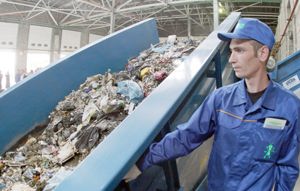From dumps to counters
The government is going to borrow 100 million dollars from the World Bank to build garbage recycling plants
The Ministry of Regional Development, Construction and Housing is going to receive a 100-million dollar loan from the World Bank for infrastructure projects within the framework of the national project “Clean City.” The loan is meant for the construction of garbage recycling plants in 10 Ukrainian cities. This information appeared on the website of the ministry with reference to the results of the meeting of the First Deputy Ministery on Regional Development, Construction and Housing of Ukraine Yurii Khivrych with the bank’s representatives to discuss the preparation of a new partnership strategy for 2012-15.
The Clean City Project provides for building garbage recycling plants or municipal solid waste (paper, glass and plastic) recycling lines, which will produce recyclable materials and utilize the rests. The plants are to be funded through investments. Estimates and documentation are ready for four cities: Voznesensk (45 million hryvnias), Ternopil (24 million hryvnias), Chernivtsi (60 million hryvnias) and Ivano-Frankivsk (34 million hryvnias). Six more cities are still to be selected.
Experts interviewed by The Day approve of the government’s intentions to launch garbage recycling, as the country will soon choke on trash. Garbage recycling is a profitable business all over the world. In Ukraine people stubbornly refuse to notice the gold under their feet and continue to pollute ravines, rivers and forest belts with tons of waste. “In Europe Nobody piles up garbage in landfills, they immediately take it with garbage trucks for recycling,” the head of the Nationwide Ecology League Tetiana Tymochko told The Day. For example, in Sweden 92 percent of the overall amount of municipal waste is recycled. In Europe, the amount of totally recycled waste averages 56 percent.”
The expert believes that there are several ways to work with garbage: one may either burn it or recycle and produce recyclable goods, like plastic sewer manholes, which may replace the iron ones.
According to Tymochko, Europeans continue to steer clear of burning garbage because it has a detrimental effect on the environment and people’s health. Burning one ton of municipal waste leads to an emission of 8,000 cubic meters of harmful gases into the atmosphere. “Every ton of burnt garbage leads to the creation of a 250-400 kilogram slag, and 50-100 kilograms of ashes, which also contain toxic substances. And the gases (oxides of carbon and sulphur, dioxins etc.) are extremely harmful for humans,” Tymochko noted, adding that dioxins cause malignant tumors. Thus, in Europe a special law forbids the usage of garbage burning plants, moving to the partial burning of sorted garbage. Besides, European producers of home appliances are forced to recycle the old appliances they produced.
According to Serhii Yermilov, director of the Institute for Ecological Problems and Energy Safety and former head of the National Agency of Ukraine on questions of energy efficiency, said that Japan has no place for landfills. Hence, every city district builds a small garbage incineration plant of the closed type, which has no traditional pipe into the atmosphere or water. For example, a total of 20 similar plants operate in Tokyo. The Japanese plants apply the so-called plasma technique, in which the temperature rises up to 3,000 degrees. Such a high temperature makes the garbage fall apart into four components: technical water, scrap metal, granules for construction and compressed gas for heating. Moreover, Yermilov continues, the Japanese populace has a highly-developed culture of recycling and sorting garbage. Garbage collecting companies give people bags for different kinds of garbage (glass, metal, plastic and municipal solid waste), which they later throw into different containers, after which the garbage is burned or recycled. There are also plants where burning sorted garbage is only one of production stages.
All these technologies are known in Ukraine, yet nobody hurries to implement them, preferring to pile up heaps of garbage instead.
According to Khivrych, nearly 50 million cubic meters of municipal waste are accumulated each year in Ukraine on almost 50,000 landfills and dumps. Six percent of these have been exhausted and are overloaded at the moment, and 22 percent don’t meet sanitary standards. Besides, garbage is removed from a mere 70 percent of the whole area.
Overall, according to Tymochko’s estimates, two percent of garbage are recycled in Ukraine, whereas less than one is incinerated — and most of this is in the capital. According to experts, out of the stockpiled 700,000 tons of garbage in Kyiv, only eight percent at most are recycled. But this is an approximate figure, as there is no single structure to survey or account for the garbage. For the most part it is brought to the Fifth Landfill, and a small part is burnt at the garbage incineration plant Enerhia, Tymochko explains. Incidentally, in 2011 Kyiv authorities plan to rebuild the plant.
Tymochko considers that Ukraine should put an end to the ideology of building outdated primitive garbage burning plants because they cause immense damage to the environment. The expert recommends using the Japanese experience. According to her estimates, one such plant with a capacity of 100,000 tons will cost 70 million dollars.
Yermilov, in turn, suggests building garbage incineration plants of the closed type in the cities with a population of over one million pe-ople (one such plant costs 500 million), and recycling ones in medium-sized and small towns.






